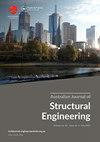Finite element modelling of RC slabs strengthened against punching shear with L-CFRP laminates
IF 0.9
Q4 ENGINEERING, CIVIL
Australian Journal of Structural Engineering
Pub Date : 2022-05-24
DOI:10.1080/13287982.2022.2079165
引用次数: 0
Abstract
ABSTRACT Punching shear strengthening of existing reinforced concrete (RC) flat slabs can be required due to increased loads or design/construction defect. One of the more effective punching shear strengthening solutions, which has shown promising results is the use of post-installed L-shaped carbon fibre-reinforced polymer (L-CFRP) laminates bonded into predrilled holes through the slab in specific shear perimeter arrangements around the column. This paper presents an extensive finite element analysis (FEA) into RC slabs strengthened in punching shear using L-CFRP laminates. FEA models were developed using an existing experimental study as the baseline. After successful model calibration, parametric studies were used to explore the influence of critical parameters such as the concrete strength (32, 40 and 60 MPa) and the number of shear perimeters on the resulting punching shear capacity. In total, four RC slabs were modelled including an unstrengthened control specimen and an additional three specimens with different strengthening arrangements. A bond-slip model was introduced between the CFRP and the concrete and its calibration was described in this paper. Simulation results are compared with the experimental results in terms of load–deflection behaviour, FRP strains and crack patterns. The predicted peak loads calculated from the design codes and critical shear crack theory (CSCT) are compared and discussed in conjunction with the experimental and FEA results. The failure mode for the slabs were also compared with design codes and CSCT theory predictions. The study demonstrated the FEA results to have a good agreement with the experimental results in terms of load deflection behaviour, failure mode and L-CFRP strains.用L-CFRP加固钢筋混凝土板抗冲剪的有限元模拟
由于荷载增加或设计/施工缺陷,可能需要对现有钢筋混凝土(RC)平板进行冲剪加固。一种更有效的冲孔剪切加固解决方案是使用后安装的l型碳纤维增强聚合物(L-CFRP)层压板,通过柱周围的特定剪切周长安排将其粘合到板上的预钻孔中,这已显示出良好的效果。本文对采用L-CFRP板进行冲剪加固的RC板进行了广泛的有限元分析。以已有的实验研究为基础,建立了有限元模型。模型标定成功后,通过参数化研究探讨混凝土强度(32、40和60 MPa)和剪切周长数等关键参数对冲剪承载力的影响。总共模拟了四块RC板,包括一个未加固的对照试件和另外三个不同加固安排的试件。本文介绍了碳纤维布与混凝土的粘结滑移模型,并对该模型进行了标定。模拟结果与试验结果在荷载-挠曲行为、FRP应变和裂纹模式方面进行了比较。结合试验和有限元分析结果,对设计规范和临界剪切裂纹理论计算的预测峰值荷载进行了比较和讨论。并与设计规范和CSCT理论预测结果进行了比较。研究表明,有限元分析结果与试验结果在荷载挠曲行为、破坏模式和L-CFRP应变方面有较好的一致性。
本文章由计算机程序翻译,如有差异,请以英文原文为准。
求助全文
约1分钟内获得全文
求助全文
来源期刊

Australian Journal of Structural Engineering
ENGINEERING, CIVIL-
CiteScore
2.50
自引率
0.00%
发文量
31
期刊介绍:
The Australian Journal of Structural Engineering (AJSE) is published under the auspices of the Structural College Board of Engineers Australia. It fulfils part of the Board''s mission for Continuing Professional Development. The journal also offers a means for exchange and interaction of scientific and professional issues and technical developments. The journal is open to members and non-members of Engineers Australia. Original papers on research and development (Technical Papers) and professional matters and achievements (Professional Papers) in all areas relevant to the science, art and practice of structural engineering are considered for possible publication. All papers and technical notes are peer-reviewed. The fundamental criterion for acceptance for publication is the intellectual and professional value of the contribution. Occasionally, papers previously published in essentially the same form elsewhere may be considered for publication. In this case acknowledgement to prior publication must be included in a footnote on page one of the manuscript. These papers are peer-reviewed as new submissions. The length of acceptable contributions typically should not exceed 4,000 to 5,000 word equivalents. Longer manuscripts may be considered at the discretion of the Editor. Technical Notes typically should not exceed about 1,000 word equivalents. Discussions on a Paper or Note published in the AJSE are welcomed. Discussions must address significant matters related to the content of a Paper or Technical Note and may include supplementary and critical comments and questions regarding content.
 求助内容:
求助内容: 应助结果提醒方式:
应助结果提醒方式:


